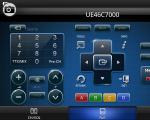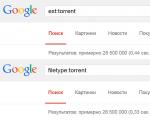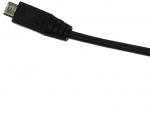How to remove a system update. Uninstall Windows updates. Clearing the update log
By default, Microsoft's OS is configured to automatic search and installing the latest patches - this helps to quickly “close” system vulnerabilities, but sometimes such a solution disrupts the stable operation of the computer. This article will show you how to remove Windows 7 updates, and we will look at the process using the example of two situations:
The update was installed successfully
Let's say we want to understand how to remove the KB971033 update in Windows when it was automatically added without your participation. In this case, go to Control Panel → Programs and Features (Add or Remove Programs) → View updates.1. This is where the system stores all already installed updates. We left-click on what interests us, the “Delete” button will appear at the top.

2. When you press it, the OS will immediately request confirmation, after which it will ask you to wait a few minutes (depending on the size of the update). When the window asking you to wait disappears, the job is done. Just in case, it's better to restart your computer. The only disadvantage of this method is that one update is removed at a time. If you want to remove a lot, you will have to be patient.
Error installing update
Before the procedure, be sure to create a system restore point so that you can return to it if something goes wrong.
The problem here is this: uninstalled packages “hang” in the list, preventing themselves from being removed and reinstalled. There is only one way out - clear the list.
1. To do this, open the Start menu, enter “services.msc” in the search bar and run the found file.
2. In the list of services, find "Windows Update", right-click and select "Stop".

3. Go to " C:WindowsSoftwareDistribution»
4. Pay attention to 2 folders: DataStore And Download. Deleting files from Download will free up disk space, because... it stores temporary files. Usually, the system itself erases files 10 days after they are installed, but there are also misfires. If it takes up a lot of space, you can clean it.
But from DataStore delete all existing files. The installed updates will not go anywhere, but the files with the history of downloaded updates, including damaged ones, will. After that, return to Services and turn “Update Center” back on. Now, when you launch it from the Control Panel, you will see that the check for available updates has never been carried out. The last thing left to do is to let the system “for the first time” load a list of files, and then select from them the ones you need.
Conclusion
Now you know how to remove old Windows 7 updates (or install those that are causing problems). It’s easy to “clean out” updates, but once again I remind you of the importance of creating a restore point before making any changes. Following safety precautions will protect you from surprises.
Update Windows systems 10 can lead to both an improvement in its performance and the appearance of errors. In the second case, you need to remove problematic updates. You can erase stuck, uninstalled, installed and anniversary updates, as well as erase their cache. After you delete, do not forget to disable automatic download updates.
Is it possible to delete
You can remove updates, since this option is provided Windows developers. Removal can be done standard applications, so this should not cause any problems. You can erase both already installed updates involved in this moment, and old or just downloaded, not yet installed, updates.
How to remove Windows 10 updates
Updates that have already been installed on your computer can be removed using system tools, without third-party programs, just like all other types of updates. But you can do this in several ways: using the control panel, configuring computer settings and executing commands. Remember, you will need administrator rights to work with updates, so perform all actions with account having these rights.
Using system parameters
- Expand system parameters, for example using search bar Windows.
Open the "Settings" program
Go to the “Updates and Security” block
- Select the "Update Center" section.
Go to the "Update Center" section
- While in the Update Center settings, expand the Update history.
Expanding the update log
- Use the "Uninstall updates" button to go to general information about installed upgrades.
Click on the “Uninstall updates” button
- Highlight the update that is harming your system and use the Uninstall button.
Select the update and click the “Delete” button
- Please note that most updates will require a system restart to remove them, so save any unsaved projects beforehand to avoid losing them.
Click the “Yes” button
Using the control panel
This method allows you to erase updates using the same list that was described in the previous method, but the transition to it will be done differently:
- Open the computer control panel, for example, through the Windows search bar.
Open the control panel through the Windows search bar
- Change appearance panel by selecting the “Large Icons” category and go to the “Programs and Features” section.
Go to the “Programs and Features” section
- Go to view installed updates.
Let's move on to viewing installed updates
- Select the update that is interfering with your system and click on the “Uninstall” button.
Click on the “Delete” button
- Confirm the action and wait until the system removes the update. Please note that most updates will require you to restart your computer to remove them, so save any unsaved projects beforehand to avoid losing them.
We confirm that the update needs to be removed
Through command execution
- Expand command line by using administrator rights.
Open command prompt as administrator
- Use the wmic qfe list brief /format:table command to view a list of installed updates and their unique numbers that will be needed for removal. Unique numbers start with KB.
Run the command wmic qfe list brief /format:table
- Use the wusa /uninstall /kb:unique_update_digits command to uninstall the desired update. Please note that the letters KB and numbers are separated by a colon and not written in a row.
Run the command wusa /uninstall /kb:unique_update_digits
- Confirm the action.
We agree with deletion
- Choose whether you want to reboot now or do it later. The update will not be completely removed until the computer is restarted.
Choose whether to restart your computer now or later
Video: Uninstalling updates
Through a third party program
This additional method, which should be resorted to only if the previous ones in your case do not help solve the problem, since this is the longest, albeit simplest, option.
- First you need to create a third-party recovery media with the ERD Commander program, which can be downloaded for free from the developer’s official website. But before that, you need to prepare this media: insert the flash drive into the port, wait until it is recognized by the system, and, while in Explorer, right-click on it, select “Format”.
Select the “Format” function
- Format the flash drive to FAT32 or NTFS format so that there is nothing unnecessary left on it.
Selecting the formatting format
- Now write the downloaded ERD Commander image onto it, to do this, click on the image right button mouse, select “Mount” and indicate on which media you want to mount the image.
Select “Mount”
- Turn off the computer without removing the flash drive. Start running it, and as soon as the first signs appear that the computer has started to turn on, press the Delete key several times to enter the BIOS. The key may be different from Delete, which one to use instead depends on your model motherboard. But when the system starts booting, you will see a prompt that will tell you which key you can use to enter the BIOS.
Enter the BIOS by pressing the Delete key
- Being in BIOS settings, switch to Boot section or “Loading” in the Russian version.
Go to the Boot section
- You must change the boot order so that the computer starts booting from the media you created, and not from hard drive, so in the menu that opens, put the name of the flash drive first instead of the hard drive.
We put the flash drive first
- Save the changes made and exit the BIOS, the system will start booting again, but it will not start Windows, but ERD Commander.
Save the changes and exit the BIOS
- Choose your version operating system.
Select your OS version
- Select the option “Run various MSDaRT recovery tools”, and then the “Remove patches” function.
Select the option “Run various MSDaRT recovery tools”
- Select the update you want to remove.
- After uninstallation, you will receive a report on which updates were removed. Done, you can return to working with the system by again changing the boot order in the BIOS so that it starts with the hard drive.
The update was successfully removed
Removing the anniversary update
An Anniversary Update is a global update that usually has a circular version, such as "Update v2.0". You can remove such an update, but provided that 10 days have not passed since the installation of the global update:
- Go to your computer settings, for example, using the Windows search bar.
Open computer settings
- Go to the "Updates and Security" block.
Select the “Update and Security” section
- Select the "Recovery" block.
Go to the “Recovery” block
- Roll back to an earlier build. This process may take some time, during which you should not turn off the computer or interrupt the procedure by any other means.
We begin to roll back the system to the previous build
How to remove downloaded, uninstalled, frozen
All downloaded updates are stored in the computer memory in the format regular files, which you can copy to transfer to another computer, or delete. Among these files are stuck and uninstalled updates. These files are sometimes called "Update Cache".
- Open standard Windows Explorer.
Open Explorer
- Go to the Download folder, which is located along the path Main_disk:\Windows\SoftwareDistribution.
Go to the path Primary_disk:\Windows\SoftwareDistribution\Download
- While in the Downlaod folder, delete unnecessary updates based on their unique number, volume and download date.
We remove unnecessary updates by deleting folders with them
Disabling the download of a specific update using a third-party program
If you deleted a certain update, then after some time it will be downloaded and installed again, since the system will understand, after checking the database, that it is missing on the computer and will install it. To avoid this, we will use the official program from Microsoft - Show or Hide Updates, which can be downloaded from their official website.
- After launching the application, search for uninstalled updates by clicking on the “Next” button.
Click the Next button
- Select Hide updates mode to hide updates.
We note updates that should not be installed independently
Disabling installation of all updates
By default, updates are downloaded and installed automatically; to avoid this, you need to change the system settings. Please note that for some programs you may need latest versions updates, so disable self-installation not always recommended.
Standard method
- Launch the Run window by holding down the Win+R key combination on your keyboard.
Launch the Run program by holding Win + R
- Use the service.msc command to get to the list of services.
Execute the command service.msc
- Find the update center in the general list and double-click on it with the left mouse button.
Select the service "Center" Windows updates»
- The service properties will open, in which you need to click the “Stop” button to disable the search for updates until the next computer restart, and set the startup type to “Disabled” so that the update center never starts and, accordingly, cannot search for and install updates.
Disable the service and change the startup type to “Disabled”
Using a third party program
If standard way for some reason is not suitable for you, you can use a third-party program Win Updates Disabler, portable version which is distributed free of charge and does not require installation

What to do if updates are not removed
If you are unable to remove updates, try the following methods:
- carry out the uninstallation process through the command line running as administrator or a third-party program. These two methods are described in detail above in the section “Removing installed updates”;
- roll back the system to a restore point created when the update was not yet installed, or go through the system restore process. For the first method, you will need a recovery point created automatically by you or the system; for the second method, a system image recorded on third-party media. Also you can do Windows reset, which will return the system to initial settings. Please note that in some cases, all data stored on your computer may be lost, so save it to a third-party reliable medium in advance so as not to lose it;
- if the above methods did not help, then reinstall the system and turn off automatic update, to control independently which updates to install and which not.
System rollback
You can roll back to a restore point to remove the update using the following steps:
- Using the Windows search bar, find the “Recovery” section.
Select restore points and roll back the system
Clearing log history
Clearing the update history may cause system failure, so this operation is recommended only as a last resort. There are frequent cases when, after cleaning, users crashed Windows or had other problems with the system. Create a system restore point in advance and save all important files to third-party media to avoid losing them. If you still decide to clear the history, then open a command prompt with administrator rights and run following commands one by one:
- net stop wuauserv
- del %systemroot%\SoftwareDistribution\DataStore\Logs\edb.log
- net start wuauserv
Done, the log should be clear, you may need to restart your computer.
Installed and uninstalled updates can be removed using standard methods or using third party program. After deleting the update, do not forget to prevent it from being installed again, otherwise the system will restore it every time it notices it is missing.
Anyone who hears the word “updates” for the first time will say that these are certain measures aimed at improving the product. Their task is to correct bugs and shortcomings in any program, not necessarily in Windows 7. For example, a year after the release of the application, the company decided to improve the interface and released a package of updates that the user must download and install, after which he will see these changes.
Updates in Windows 7 are usually aimed at fixing security problems and compatibility of the operating system with drivers and programs. This also includes compatibility issues with programs that require installation software platform Microsoft. Net Framework and so on.
Unfortunately, you cannot avoid problems with updates - after a while they become irrelevant, as new ones appear to replace them. In this regard, a “dump” arises in the section with installed updates, and I also want to have more free space on my hard drive.
There is only one solution: remove all Windows 7 updates and reinstall only the ones you need. But what if you have a thousand of them? Windows 7 does not have a function that allows you to uninstall all updates at once, so you cannot do without third-party software.
Problems that may arise during a deupdate
It is recommended to create a system restore point, since the methods discussed in this article can lead to unpleasant consequences, for example, certain programs may fail to work, the OS may begin to “slow down,” which may result in a system crash, etc. The only way to fix this is to roll back Windows 7 to the point when the updates were installed.
Not all updates will be removed, only those that do not require user action. The remaining updates will have to be uninstalled manually.
First, let's look at a simpler method that will take literally a few minutes of your time, while the second one is longer and requires certain software. All these processes will not interact in any way with the update center. Just in case, temporarily disable the search for updates to successfully complete operations.
Uninstalling Windows 7 updates via batch file
Do you know a method to remove updates via the command line? So, this method simplifies it: now you won’t have to enter the command “wusa.exe/uninstall/ update number” every time - all possible updates will be automatically removed from your computer.
Let's create a file with the extension .bat (batch file). To do this, write the following code in notepad:
@echo off
color 0A
mode con: cols=40 lines=12
setlocal enabledelayedexpansion
Set templist=%TEMP%\listTMP.txt
set list=%USERPROFILE%\Desktop\uninstall_updates.cmd
echo.
echo.
echo Please wait
echo.
echo.
if exist %templist% del %templist%
if exist %list% del %list%
wmic qfe get hotfixid>>%templist%
call:1 "KB" "KB:"
echo DONE
timeout /t 3 /nobreak > nul
exit /b
:1
for /f "tokens=1* delims=]" %%a in ("find /v /n "" ^<"%templist%"") do (
if not "%%b"=="" (set line=%%b) else (set line=not)
set newline=!line:%~1=%~2!
set newline=!newline:not=!
echo wusa.exe /uninstall /!newline!/quiet /norestart>>%list%
::set templist=%list%
goto:eof
Then save with .bat at the end of the file name, selecting “All files”. After running it, uninstall_updates.exe will appear on your desktop. To begin the update removal procedure, run it and wait for the process to complete (the command line window will automatically close).

In my case, when the program finished its work, only 90 modifications remained out of 233. We can safely say that its task was partially completed. Restart your computer to reconfigure Windows.

Uninstalling updates using Revo Uninstaller
To complete the update removal process, we need the Revo Uninstaller program. You can buy it on the developer’s website for $39 or download it somewhere, it’s up to you.


After launching Revo Uninstaller, we see a list of programs available for removal, but there are no updates here. To fix this, in the top menu, click on the “Tools” tab and select the section with parameters (Alt + O). In the navigation panel on the left, click on the “All programs” item and check the necessary settings: show system updates, show system components, click “OK” and you will notice significant changes in the list of programs - applications will appear, the name of which will contain the update number.
Select them and click “Delete”. Of course, this method requires certain actions from the user, but you do not have to manually click on each component in the Windows 7 update center.
No matter how large the computer disk allocated for the system volume is, there is often a catastrophic lack of memory on it.
Relatively recently, in order to free up space in this important directory, the user only had to dump some of his files onto a 1.4 Mb floppy disk, after which he could continue to work quietly on the PC for a long time.
Modern computers have tens of gigabytes of disk space, and sometimes even terabytes, however, the problem of lack of memory is still relevant.
Below is a guide with techniques for safely deleting unnecessary Windows 7 update files to avoid unpleasant situations with system crashes and errors.
Where are updates stored and what are they for?
The longer the “Seven” is used, the more upgrades are downloaded for it and the more space it takes up on the computer.
Therefore, the question of which system updates can be safely removed is quite obvious to any user.
Updates are stored in the “WinSxS” system directory and may be necessary, if necessary, to roll back the system to a working state as a result of failures.
 If the PC owner does not need to do this, then erasing unused updates will not have negative consequences for the functionality of the OS.
If the PC owner does not need to do this, then erasing unused updates will not have negative consequences for the functionality of the OS.
After installing the packages, the old files are saved on the PC and if the last upgrade led to a failure, for example, in Windows XP, Vista, 7 and 8, many users, after upgrading the OS, encountered error 87, the elimination of which requires time-consuming adjustments to the registry, or a system rollback, which is possible when saving previous update files stored in the “WinSxS” directory.
 If the “Seven” has been working stably for a long time and the user has sufficient experience in operating a computer, then he can quickly free up significant space on the hard drive of his home electronic friend.
If the “Seven” has been working stably for a long time and the user has sufficient experience in operating a computer, then he can quickly free up significant space on the hard drive of his home electronic friend.
 After all, a folder with “ballast” usually weighs at least 4 Gb.
After all, a folder with “ballast” usually weighs at least 4 Gb.
Removal techniques
Initially, in Windows 7, Microsoft specialists did not provide a tool for getting rid of old system update files.
Therefore, PC owners had to use workarounds to free up valuable disk space on the hard drive.
Fortunately, the developers have released a special package “KB2852386”, which makes this process safe and easy to perform even for novice users.
 If this package is not installed automatically, then this wizard can be manually downloaded and installed on the official Microsoft resource.
If this package is not installed automatically, then this wizard can be manually downloaded and installed on the official Microsoft resource.
Its exact name is “Windows Cleanup Tool”.
Thus, to the question: “Is it possible to delete old saved updates from the system volume?” - Microsoft itself has already responded positively, but there is one very important condition.
This cleaner successfully copes with its tasks, both in 32-bit Semerka and x64, but you should definitely take into account that the installation of this wizard for cleaning old files is only possible if Semerka is updated to SP1.
The methods below will help you erase previously installed upgrades from your computer’s memory and remove updates that have not yet been installed on the system.
Method 1: Using the Cleanup Wizard

The following sequential steps must be performed:
Note: After some time, updates will begin to download to the PC again, which will again require wiping the disk. Therefore, it is recommended to carry out this activity to remove update files quarterly.
Or you can disable the service for automatically downloading and installing upgrades (how to do this is described later in this guide).
The method through the “Control Panel” (CP) is very convenient to perform and allows you to achieve maximum effect. The following steps are required:

To do this, hold down “Win”, click “R” and then type “wuapp” in the window that appears;


Method 3: Using the command line features in Windows 7
You cannot ignore the method using the “almighty” OS console, or as it is more often called the “Command Line” (CL). The sequence of actions consists of the following stages:


Method 4. How to remove manually?
You can also use the manual mode of removing updates from the “WinSxS” directory, but first you must deactivate the update service.
 The following steps must be taken:
The following steps must be taken:

Method 5. How to remove only installation files?
You need to do the following:





